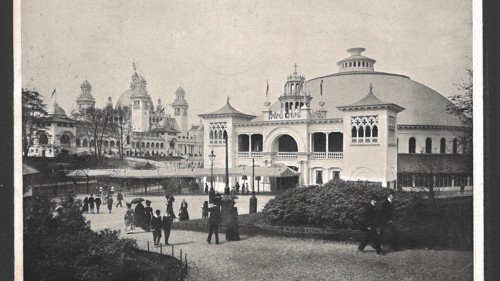1901 Exhibition - Times Past

In partnership with the Glasgow Times, our archivists are exploring Glasgow's fascinating history. This week, Nerys Tunnicliffe writes about the International Exhibition of 1901.
The 1901 Glasgow International Exhibition is one of those events that I wish you could travel back in time to enjoy with its ‘switchback’ railway, water chute and Indian Theatre. Although its aim was partly educational, with pavilions from countries such as Japan and France, it had many appealing amusements such as a grand concert hall and gondola rides on the River Kelvin.
The city was proud of its booming global trade links, and role in innovations in science, industry and art. This led to a series of four large-scale exhibitions in the late 19th and early 20th century all aimed at showcasing achievements in Glasgow and nationwide.
The first in 1888, the International Exhibition of Science, Art and Industry, had been a huge triumph with over 5 million visitors. After the success of the 1888 exhibition there was an eagerness to replicate the event. The opening of the new Kelvingrove Art Gallery and Museum seemed just the perfect occasion for the city to host another exhibition, especially as the Kelvingrove was financed by the profits of the first exhibition.
It’s clear that from the meeting minutes of the Glasgow International Exhibition Association now held at the City Archives, that the 1901 exhibition throughout its planning was considerably influenced by its 1888 predecessor. As before, the 1901 event was held in Kelvingrove Park and many of its buildings, such as the white and gold Industrial Hall by artist and architect James Miller, were based on oriental architecture (interestingly, Charles Rennie Mackintosh submitted a design but lost out to Miller).
However unlike the 1888 event, there was more than one building with the Industrial Hall topped by a golden angel with an electric torch symbolising light; the Machinery Hall, housing impressive locomotives as well as ironwork designs from Walter Macfarlane & Co; the Concert Hall with its large Venetian-style dome; all alongside the Kelvingrove which housed fine art works from artists such as Turner, Rodin and Edward Burne-Jones, recently acquired or loaned for the exhibition.
The 1901 exhibition also included pavilions from other countries, from the opulent Russian display (said to cost the Tsar £30,000) to Canada’s water cute where boats zoomed down into the River Kelvin!
The death of Queen Victoria in January 1901 may have muted the opening of the exhibition, with hopes of King Edward attending dashed. Instead the King’s daughter, the Duchess of Fife, opened the exhibition. It ran for eight months from 2 May to 4 November 1901. The exhibition still attracted 11.5 million visitors, making enough money towards purchasing more art for the Kelvingrove and further developing the city’s parks.
The Industrial Hall, Concert Hall and other temporary structures were taken down, but the Kelvingrove and its wonderful collections, Kelvingrove Park and James Miller’s Port Sunlight Cottages remain, all popular and inspiring legacies of the 1901 Glasgow International Exhibition.
